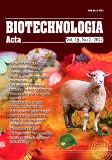ISSN 2410-7751 (Друкована версія)
ISSN2410-776X (Електронна версія)

Biotechnologia Acta Т. 15, No. 2, 2022
P. 53-55, Bibliography 8, Engl.
UDC: 617.711-002-022.7+577.112
https://doi.org/10.15407/biotech15.02.053
PROTEIN MARKERS OF HYPOXIA AND ANGIOGENESIS IN TEAR FLUID OF PATIENTS WITH TRAUMATIC CORNEAL INJURY
I. V. Gavrylyak 1, V. L. Bilous 2, V. V. Korsa 2, N. K. Greben 1
1Bogomolets National Medical University, Kyiv, Ukraine
2Palladin Institute of Biochemistry of the National Academy of Sciences of Ukraine, Kyiv
The aim of our study was to evaluate tear levels of some protein endpoints that can reflect intensities of hypoxia, angiogenesis and tissue remodeling in wounded cornea.
Methods. We examined 21 patients (21 eyes) with nonpenetrating corneal injuries. The patients underwent standard ophthalmological examination including previous history and ocular symptoms, visual acuity test, complete anterior and posterior eye segments examination using slit lamp biomicroscopy, evaluation of corneal staining with fluorescein, ophthalmoscopy. Healthy volunteers (n = 10) served as a control. Tear fluid was collected from patients and control volunteers with the use of a disposable tip micropipette. From the lower arch of the conjunctiva without instillation of anesthetic, tears were collected in a sterile plastic Eppendorf tube and frozen at -20 oC before laboratory examination. Proteins of tear fluids were separated by SDS-PAGE (loading 50 µg total protein per track). Then, levels of hypoxia inducible factor 1α (HIF-1α), vascular endothelial growth factor (VEGF), and angiostatins were measured by western blot. Active MMP-9 levels were evaluated by gelatin zymography. The results of blot and zymography assays were processed by densitometric software and then analyzed statistically with the use of Mann-Whitney U-test.
Results. Elevated HIF-1α (P<0.001) and angiostatins (P<0.05) levels were revealed by western blot in tear fluid samples collected from patients with injured cornea in comparison with the control group. It is noteworthy that extremely low amounts of VEGF were detected in tear fluid from injured eyes, in spite of abundance of its transcription inducer HIF-1α. Dramatically increased levels of active MMP-9 were found in the tear fluids of patients with corneal wounds, while no significant collagenolytic activity was observed in tears from healthy eyes. There is a strong correlation between extent of corneal lesions and changes in markers expression.
Conclusions. Tear levels of HIF-1α and angiostatin as well as MMP-9 activity could represent valuable biomarkers of corneal injury severity in traumatic eye.
Key words: Hypoxia, angiogenesis, traumatic corneal injury
© Palladin Institute of Biochemistry of the National Academy of Sciences of Ukraine, 2022
References
1. Tamhane M., Cabrera-Ghayouri S., Abelian G., Viswanath V. Review of biomarkers in ocular matrices: challenges and opportunities. Pharm. Res. 2019, 36, 1?35. https://doi.org/10.1007/s11095-019-2569-8
2. Wilson S. E. Corneal wound healing. Exp. Eye Res. 2020, 197, 1?21. https://doi.org/10.1016/j.exer.2020.108089
3. Ma J. Y. W., Sze Y .H., Bian J. F., Lam T. C. Critical role of mass spectrometry proteomics in tear biomarker discovery for multifactorial ocular diseases (Review). Int. J. Mol. Med. 2021, 47(5), 1?15. https://doi.org/10.3892/ijmm.2021.4916
4. Pang K., Lennikov A., Yang M. Hypoxia adaptation in the cornea: current animal models and underlying mechanisms. Animal Model Exp. Med. 2021, 4(4), 300?310. https://doi.org/10.1002/ame2.12192
5. Bukowiecki A., Hos D., Cursiefen C., Eming S.A. Wound-healing studies in cornea and skin: parallels, differences and opportunities. Int. J. Mol. Sci. 2017, 18(6), 1?24. https://doi.org/10.3390/ijms18061257
6. Ambati B.K., Joussen A.M., Ambati J., Moromizato Y., Guha C., Javaherian K., Gillies S., O'Reilly M.S., Adamis A.P. Angiostatin inhibits and regresses corneal neovascularization. Arch. Ophthalmol. 2002, 120 (8), 1063?1068. https://doi.org/10.1001/archopht.120.8.1063
7. Chen Y.H., Wu H.L., Chen C.K., Huang Y.H., Yang B.C., Wu L.W. Angiostatin antagonizes the action of VEGF-A in human endothelial cells via two distinct pathways. Biochem. Biophys. Res. Commun. 2003, 310(3), 804?810. https://doi.org/10.1016/j.bbrc.2003.09.081
8. Singh A, Maurya OP, Jagannadhan MV, Patel A. Matrix metalloproteinases (MMP-2 and MMP-9) activity in corneal ulcer and ocular surface disorders determined by gelatin zymography. J. Ocul. Biol. Dis. Infor. 2012, 5(2), 31?35. https://doi.org/10.1007/s12177-012-9096-8

